Negotiation Case Study: OOJ's Sale, Strategies and Tactics Analysis
VerifiedAdded on 2022/10/04
|8
|1965
|340
Case Study
AI Summary
This case study examines the negotiation strategies for Original Organic Juices (OOJ's), a beverage manufacturer facing potential sale or merger scenarios. The analysis identifies key parties, including Get Fresh Beverages, OOJ's competitor, Taylor Hardy, and Blueberry Farms Ltd., outlining their interests, issues, ZOPAs (Zones of Possible Agreement), and BATNAs (Best Alternatives to a Negotiated Agreement). It proposes negotiation tactics, such as contingent actions, improving options, and adopting integrative negotiation strategies. The case explores the current negotiation strategy of Get Fresh Beverages and how Lauren Indigo, the CFO, could transform the negotiation by addressing biases and ethical considerations. The study emphasizes the importance of understanding BATNAs and ZOPAs, and adopting cooperative negotiation approaches to achieve mutually beneficial outcomes for OOJ's and its stakeholders. The document also references relevant negotiation theories and provides recommendations for achieving favorable outcomes.
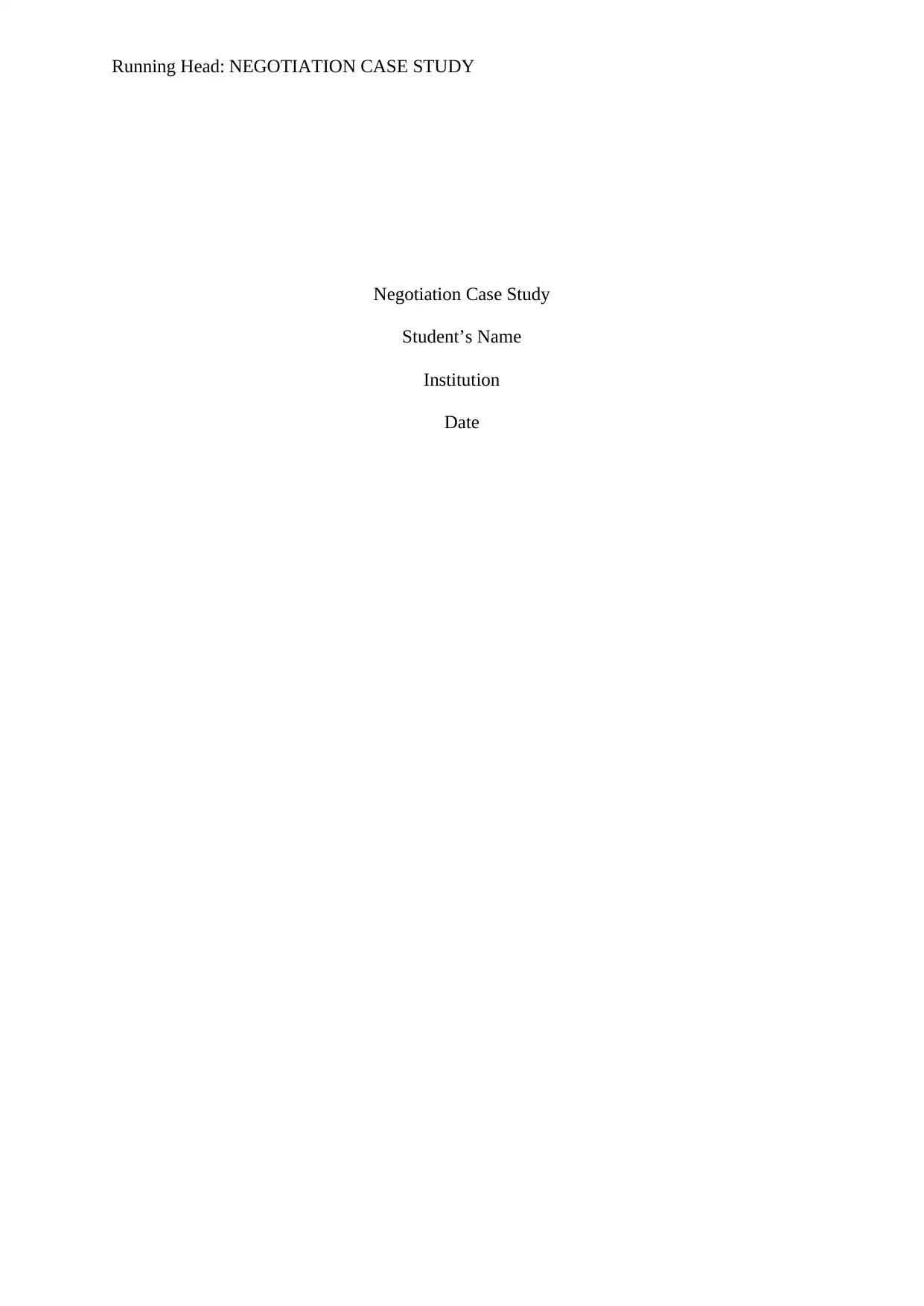
Running Head: NEGOTIATION CASE STUDY
Negotiation Case Study
Student’s Name
Institution
Date
Negotiation Case Study
Student’s Name
Institution
Date
Paraphrase This Document
Need a fresh take? Get an instant paraphrase of this document with our AI Paraphraser
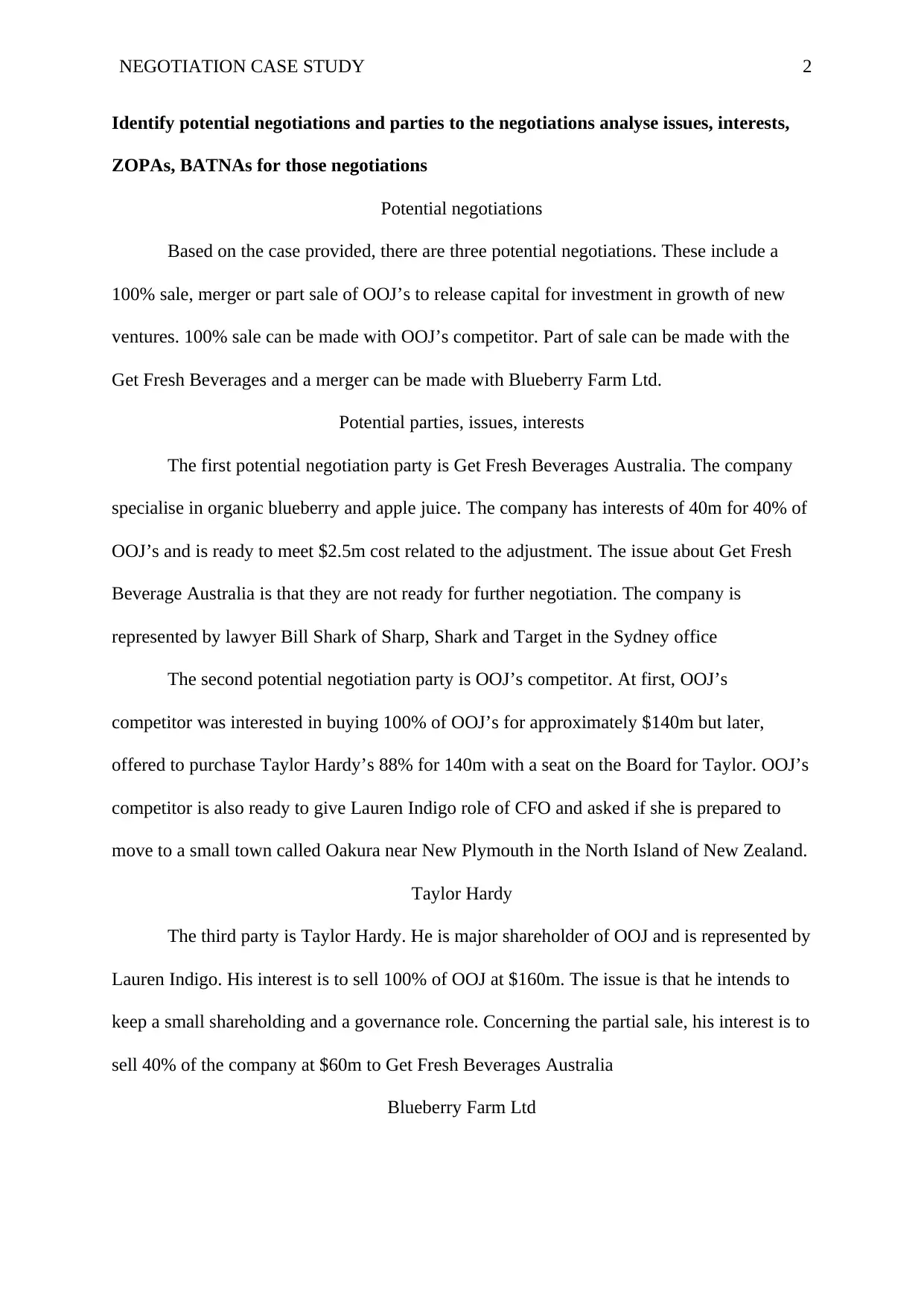
NEGOTIATION CASE STUDY 2
Identify potential negotiations and parties to the negotiations analyse issues, interests,
ZOPAs, BATNAs for those negotiations
Potential negotiations
Based on the case provided, there are three potential negotiations. These include a
100% sale, merger or part sale of OOJ’s to release capital for investment in growth of new
ventures. 100% sale can be made with OOJ’s competitor. Part of sale can be made with the
Get Fresh Beverages and a merger can be made with Blueberry Farm Ltd.
Potential parties, issues, interests
The first potential negotiation party is Get Fresh Beverages Australia. The company
specialise in organic blueberry and apple juice. The company has interests of 40m for 40% of
OOJ’s and is ready to meet $2.5m cost related to the adjustment. The issue about Get Fresh
Beverage Australia is that they are not ready for further negotiation. The company is
represented by lawyer Bill Shark of Sharp, Shark and Target in the Sydney office
The second potential negotiation party is OOJ’s competitor. At first, OOJ’s
competitor was interested in buying 100% of OOJ’s for approximately $140m but later,
offered to purchase Taylor Hardy’s 88% for 140m with a seat on the Board for Taylor. OOJ’s
competitor is also ready to give Lauren Indigo role of CFO and asked if she is prepared to
move to a small town called Oakura near New Plymouth in the North Island of New Zealand.
Taylor Hardy
The third party is Taylor Hardy. He is major shareholder of OOJ and is represented by
Lauren Indigo. His interest is to sell 100% of OOJ at $160m. The issue is that he intends to
keep a small shareholding and a governance role. Concerning the partial sale, his interest is to
sell 40% of the company at $60m to Get Fresh Beverages Australia
Blueberry Farm Ltd
Identify potential negotiations and parties to the negotiations analyse issues, interests,
ZOPAs, BATNAs for those negotiations
Potential negotiations
Based on the case provided, there are three potential negotiations. These include a
100% sale, merger or part sale of OOJ’s to release capital for investment in growth of new
ventures. 100% sale can be made with OOJ’s competitor. Part of sale can be made with the
Get Fresh Beverages and a merger can be made with Blueberry Farm Ltd.
Potential parties, issues, interests
The first potential negotiation party is Get Fresh Beverages Australia. The company
specialise in organic blueberry and apple juice. The company has interests of 40m for 40% of
OOJ’s and is ready to meet $2.5m cost related to the adjustment. The issue about Get Fresh
Beverage Australia is that they are not ready for further negotiation. The company is
represented by lawyer Bill Shark of Sharp, Shark and Target in the Sydney office
The second potential negotiation party is OOJ’s competitor. At first, OOJ’s
competitor was interested in buying 100% of OOJ’s for approximately $140m but later,
offered to purchase Taylor Hardy’s 88% for 140m with a seat on the Board for Taylor. OOJ’s
competitor is also ready to give Lauren Indigo role of CFO and asked if she is prepared to
move to a small town called Oakura near New Plymouth in the North Island of New Zealand.
Taylor Hardy
The third party is Taylor Hardy. He is major shareholder of OOJ and is represented by
Lauren Indigo. His interest is to sell 100% of OOJ at $160m. The issue is that he intends to
keep a small shareholding and a governance role. Concerning the partial sale, his interest is to
sell 40% of the company at $60m to Get Fresh Beverages Australia
Blueberry Farm Ltd
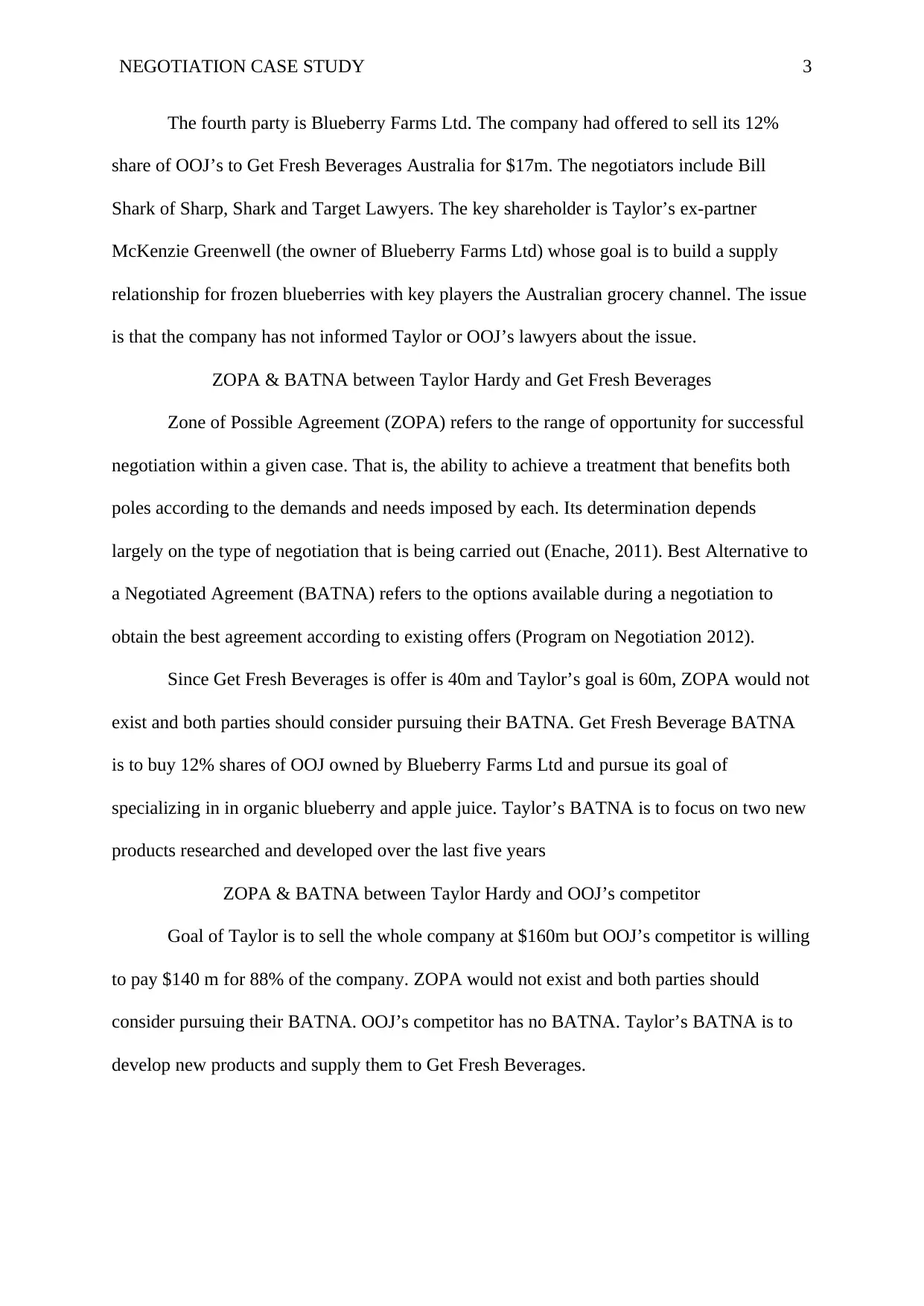
NEGOTIATION CASE STUDY 3
The fourth party is Blueberry Farms Ltd. The company had offered to sell its 12%
share of OOJ’s to Get Fresh Beverages Australia for $17m. The negotiators include Bill
Shark of Sharp, Shark and Target Lawyers. The key shareholder is Taylor’s ex-partner
McKenzie Greenwell (the owner of Blueberry Farms Ltd) whose goal is to build a supply
relationship for frozen blueberries with key players the Australian grocery channel. The issue
is that the company has not informed Taylor or OOJ’s lawyers about the issue.
ZOPA & BATNA between Taylor Hardy and Get Fresh Beverages
Zone of Possible Agreement (ZOPA) refers to the range of opportunity for successful
negotiation within a given case. That is, the ability to achieve a treatment that benefits both
poles according to the demands and needs imposed by each. Its determination depends
largely on the type of negotiation that is being carried out (Enache, 2011). Best Alternative to
a Negotiated Agreement (BATNA) refers to the options available during a negotiation to
obtain the best agreement according to existing offers (Program on Negotiation 2012).
Since Get Fresh Beverages is offer is 40m and Taylor’s goal is 60m, ZOPA would not
exist and both parties should consider pursuing their BATNA. Get Fresh Beverage BATNA
is to buy 12% shares of OOJ owned by Blueberry Farms Ltd and pursue its goal of
specializing in in organic blueberry and apple juice. Taylor’s BATNA is to focus on two new
products researched and developed over the last five years
ZOPA & BATNA between Taylor Hardy and OOJ’s competitor
Goal of Taylor is to sell the whole company at $160m but OOJ’s competitor is willing
to pay $140 m for 88% of the company. ZOPA would not exist and both parties should
consider pursuing their BATNA. OOJ’s competitor has no BATNA. Taylor’s BATNA is to
develop new products and supply them to Get Fresh Beverages.
The fourth party is Blueberry Farms Ltd. The company had offered to sell its 12%
share of OOJ’s to Get Fresh Beverages Australia for $17m. The negotiators include Bill
Shark of Sharp, Shark and Target Lawyers. The key shareholder is Taylor’s ex-partner
McKenzie Greenwell (the owner of Blueberry Farms Ltd) whose goal is to build a supply
relationship for frozen blueberries with key players the Australian grocery channel. The issue
is that the company has not informed Taylor or OOJ’s lawyers about the issue.
ZOPA & BATNA between Taylor Hardy and Get Fresh Beverages
Zone of Possible Agreement (ZOPA) refers to the range of opportunity for successful
negotiation within a given case. That is, the ability to achieve a treatment that benefits both
poles according to the demands and needs imposed by each. Its determination depends
largely on the type of negotiation that is being carried out (Enache, 2011). Best Alternative to
a Negotiated Agreement (BATNA) refers to the options available during a negotiation to
obtain the best agreement according to existing offers (Program on Negotiation 2012).
Since Get Fresh Beverages is offer is 40m and Taylor’s goal is 60m, ZOPA would not
exist and both parties should consider pursuing their BATNA. Get Fresh Beverage BATNA
is to buy 12% shares of OOJ owned by Blueberry Farms Ltd and pursue its goal of
specializing in in organic blueberry and apple juice. Taylor’s BATNA is to focus on two new
products researched and developed over the last five years
ZOPA & BATNA between Taylor Hardy and OOJ’s competitor
Goal of Taylor is to sell the whole company at $160m but OOJ’s competitor is willing
to pay $140 m for 88% of the company. ZOPA would not exist and both parties should
consider pursuing their BATNA. OOJ’s competitor has no BATNA. Taylor’s BATNA is to
develop new products and supply them to Get Fresh Beverages.
⊘ This is a preview!⊘
Do you want full access?
Subscribe today to unlock all pages.

Trusted by 1+ million students worldwide
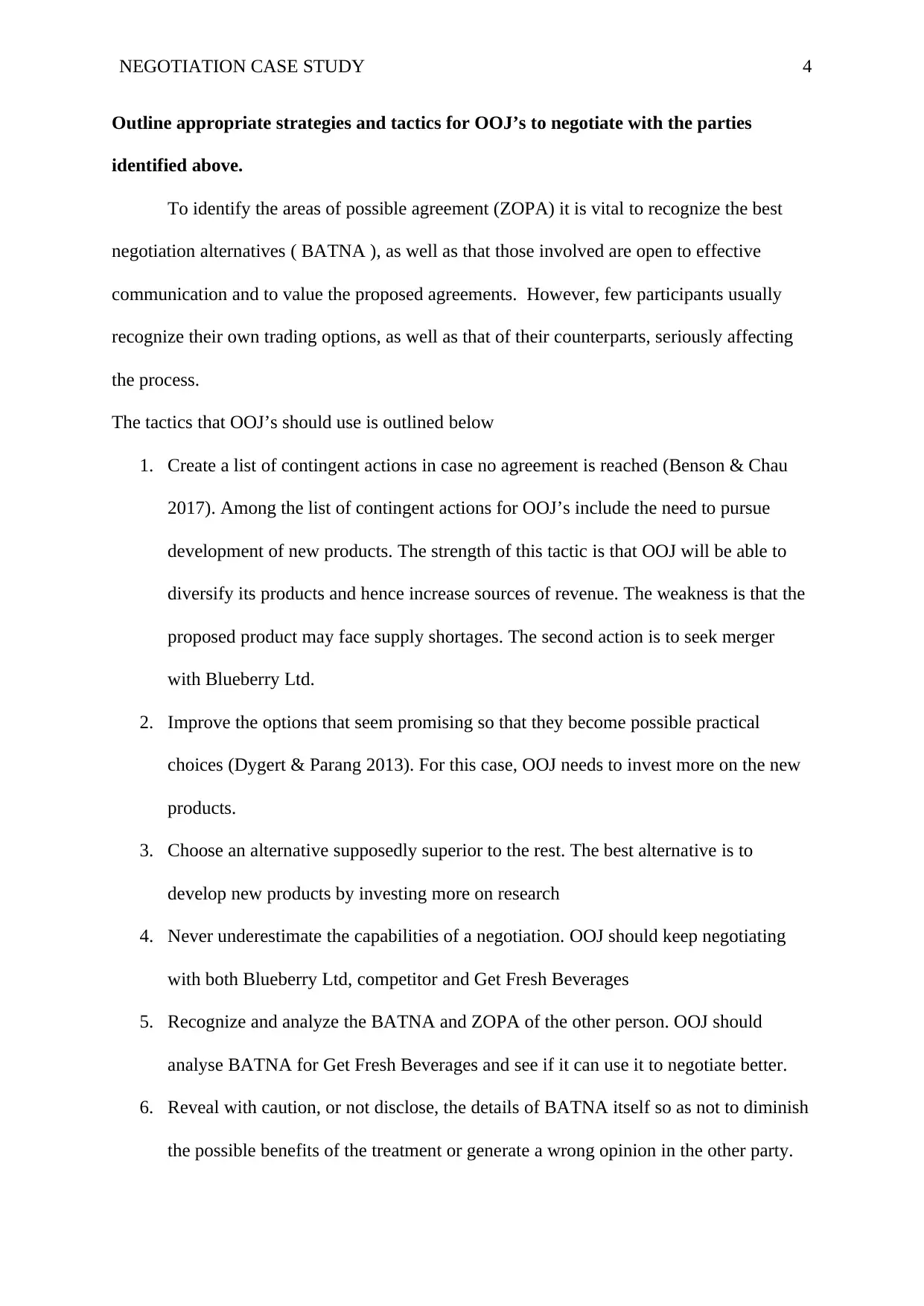
NEGOTIATION CASE STUDY 4
Outline appropriate strategies and tactics for OOJ’s to negotiate with the parties
identified above.
To identify the areas of possible agreement (ZOPA) it is vital to recognize the best
negotiation alternatives ( BATNA ), as well as that those involved are open to effective
communication and to value the proposed agreements. However, few participants usually
recognize their own trading options, as well as that of their counterparts, seriously affecting
the process.
The tactics that OOJ’s should use is outlined below
1. Create a list of contingent actions in case no agreement is reached (Benson & Chau
2017). Among the list of contingent actions for OOJ’s include the need to pursue
development of new products. The strength of this tactic is that OOJ will be able to
diversify its products and hence increase sources of revenue. The weakness is that the
proposed product may face supply shortages. The second action is to seek merger
with Blueberry Ltd.
2. Improve the options that seem promising so that they become possible practical
choices (Dygert & Parang 2013). For this case, OOJ needs to invest more on the new
products.
3. Choose an alternative supposedly superior to the rest. The best alternative is to
develop new products by investing more on research
4. Never underestimate the capabilities of a negotiation. OOJ should keep negotiating
with both Blueberry Ltd, competitor and Get Fresh Beverages
5. Recognize and analyze the BATNA and ZOPA of the other person. OOJ should
analyse BATNA for Get Fresh Beverages and see if it can use it to negotiate better.
6. Reveal with caution, or not disclose, the details of BATNA itself so as not to diminish
the possible benefits of the treatment or generate a wrong opinion in the other party.
Outline appropriate strategies and tactics for OOJ’s to negotiate with the parties
identified above.
To identify the areas of possible agreement (ZOPA) it is vital to recognize the best
negotiation alternatives ( BATNA ), as well as that those involved are open to effective
communication and to value the proposed agreements. However, few participants usually
recognize their own trading options, as well as that of their counterparts, seriously affecting
the process.
The tactics that OOJ’s should use is outlined below
1. Create a list of contingent actions in case no agreement is reached (Benson & Chau
2017). Among the list of contingent actions for OOJ’s include the need to pursue
development of new products. The strength of this tactic is that OOJ will be able to
diversify its products and hence increase sources of revenue. The weakness is that the
proposed product may face supply shortages. The second action is to seek merger
with Blueberry Ltd.
2. Improve the options that seem promising so that they become possible practical
choices (Dygert & Parang 2013). For this case, OOJ needs to invest more on the new
products.
3. Choose an alternative supposedly superior to the rest. The best alternative is to
develop new products by investing more on research
4. Never underestimate the capabilities of a negotiation. OOJ should keep negotiating
with both Blueberry Ltd, competitor and Get Fresh Beverages
5. Recognize and analyze the BATNA and ZOPA of the other person. OOJ should
analyse BATNA for Get Fresh Beverages and see if it can use it to negotiate better.
6. Reveal with caution, or not disclose, the details of BATNA itself so as not to diminish
the possible benefits of the treatment or generate a wrong opinion in the other party.
Paraphrase This Document
Need a fresh take? Get an instant paraphrase of this document with our AI Paraphraser
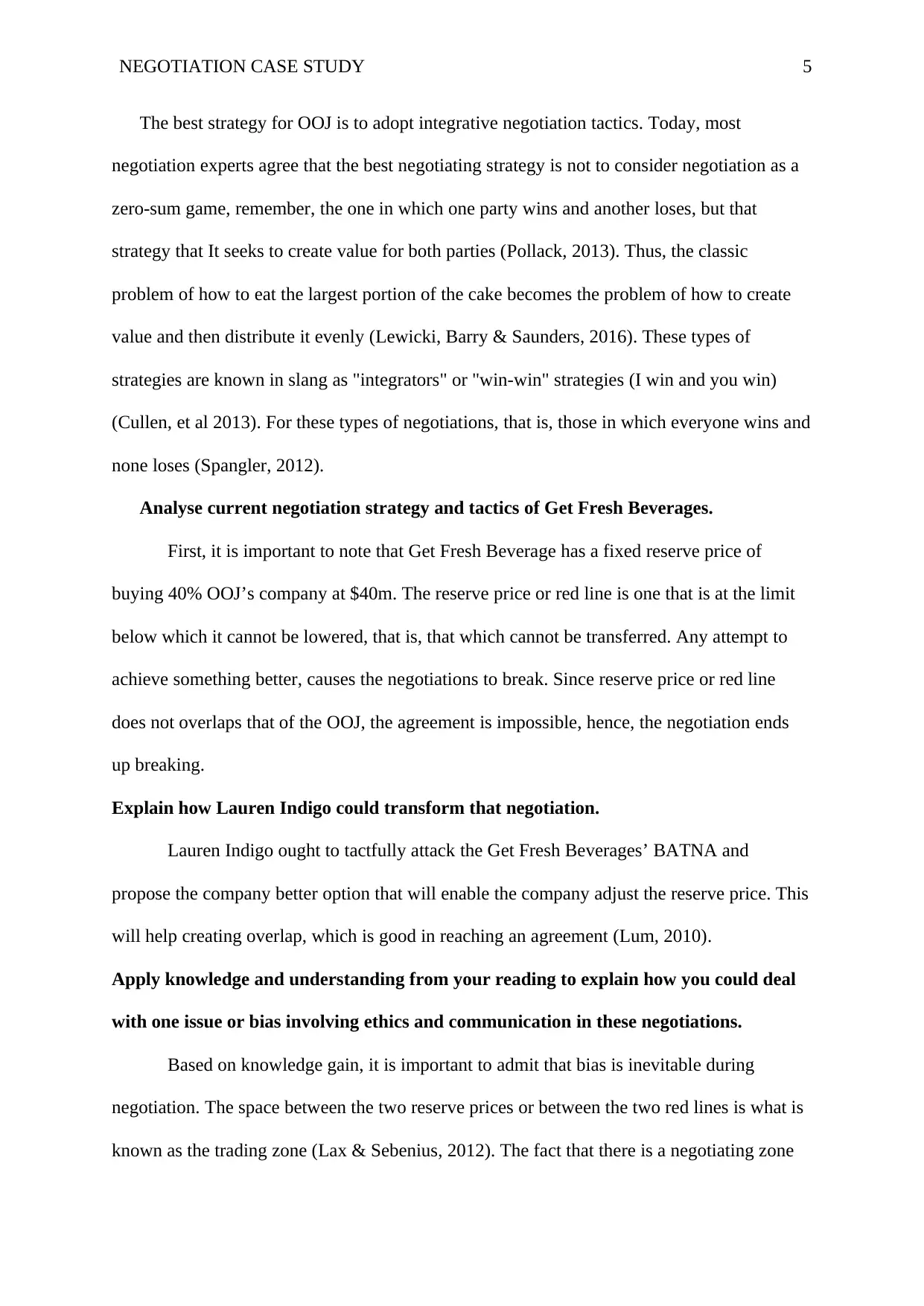
NEGOTIATION CASE STUDY 5
The best strategy for OOJ is to adopt integrative negotiation tactics. Today, most
negotiation experts agree that the best negotiating strategy is not to consider negotiation as a
zero-sum game, remember, the one in which one party wins and another loses, but that
strategy that It seeks to create value for both parties (Pollack, 2013). Thus, the classic
problem of how to eat the largest portion of the cake becomes the problem of how to create
value and then distribute it evenly (Lewicki, Barry & Saunders, 2016). These types of
strategies are known in slang as "integrators" or "win-win" strategies (I win and you win)
(Cullen, et al 2013). For these types of negotiations, that is, those in which everyone wins and
none loses (Spangler, 2012).
Analyse current negotiation strategy and tactics of Get Fresh Beverages.
First, it is important to note that Get Fresh Beverage has a fixed reserve price of
buying 40% OOJ’s company at $40m. The reserve price or red line is one that is at the limit
below which it cannot be lowered, that is, that which cannot be transferred. Any attempt to
achieve something better, causes the negotiations to break. Since reserve price or red line
does not overlaps that of the OOJ, the agreement is impossible, hence, the negotiation ends
up breaking.
Explain how Lauren Indigo could transform that negotiation.
Lauren Indigo ought to tactfully attack the Get Fresh Beverages’ BATNA and
propose the company better option that will enable the company adjust the reserve price. This
will help creating overlap, which is good in reaching an agreement (Lum, 2010).
Apply knowledge and understanding from your reading to explain how you could deal
with one issue or bias involving ethics and communication in these negotiations.
Based on knowledge gain, it is important to admit that bias is inevitable during
negotiation. The space between the two reserve prices or between the two red lines is what is
known as the trading zone (Lax & Sebenius, 2012). The fact that there is a negotiating zone
The best strategy for OOJ is to adopt integrative negotiation tactics. Today, most
negotiation experts agree that the best negotiating strategy is not to consider negotiation as a
zero-sum game, remember, the one in which one party wins and another loses, but that
strategy that It seeks to create value for both parties (Pollack, 2013). Thus, the classic
problem of how to eat the largest portion of the cake becomes the problem of how to create
value and then distribute it evenly (Lewicki, Barry & Saunders, 2016). These types of
strategies are known in slang as "integrators" or "win-win" strategies (I win and you win)
(Cullen, et al 2013). For these types of negotiations, that is, those in which everyone wins and
none loses (Spangler, 2012).
Analyse current negotiation strategy and tactics of Get Fresh Beverages.
First, it is important to note that Get Fresh Beverage has a fixed reserve price of
buying 40% OOJ’s company at $40m. The reserve price or red line is one that is at the limit
below which it cannot be lowered, that is, that which cannot be transferred. Any attempt to
achieve something better, causes the negotiations to break. Since reserve price or red line
does not overlaps that of the OOJ, the agreement is impossible, hence, the negotiation ends
up breaking.
Explain how Lauren Indigo could transform that negotiation.
Lauren Indigo ought to tactfully attack the Get Fresh Beverages’ BATNA and
propose the company better option that will enable the company adjust the reserve price. This
will help creating overlap, which is good in reaching an agreement (Lum, 2010).
Apply knowledge and understanding from your reading to explain how you could deal
with one issue or bias involving ethics and communication in these negotiations.
Based on knowledge gain, it is important to admit that bias is inevitable during
negotiation. The space between the two reserve prices or between the two red lines is what is
known as the trading zone (Lax & Sebenius, 2012). The fact that there is a negotiating zone
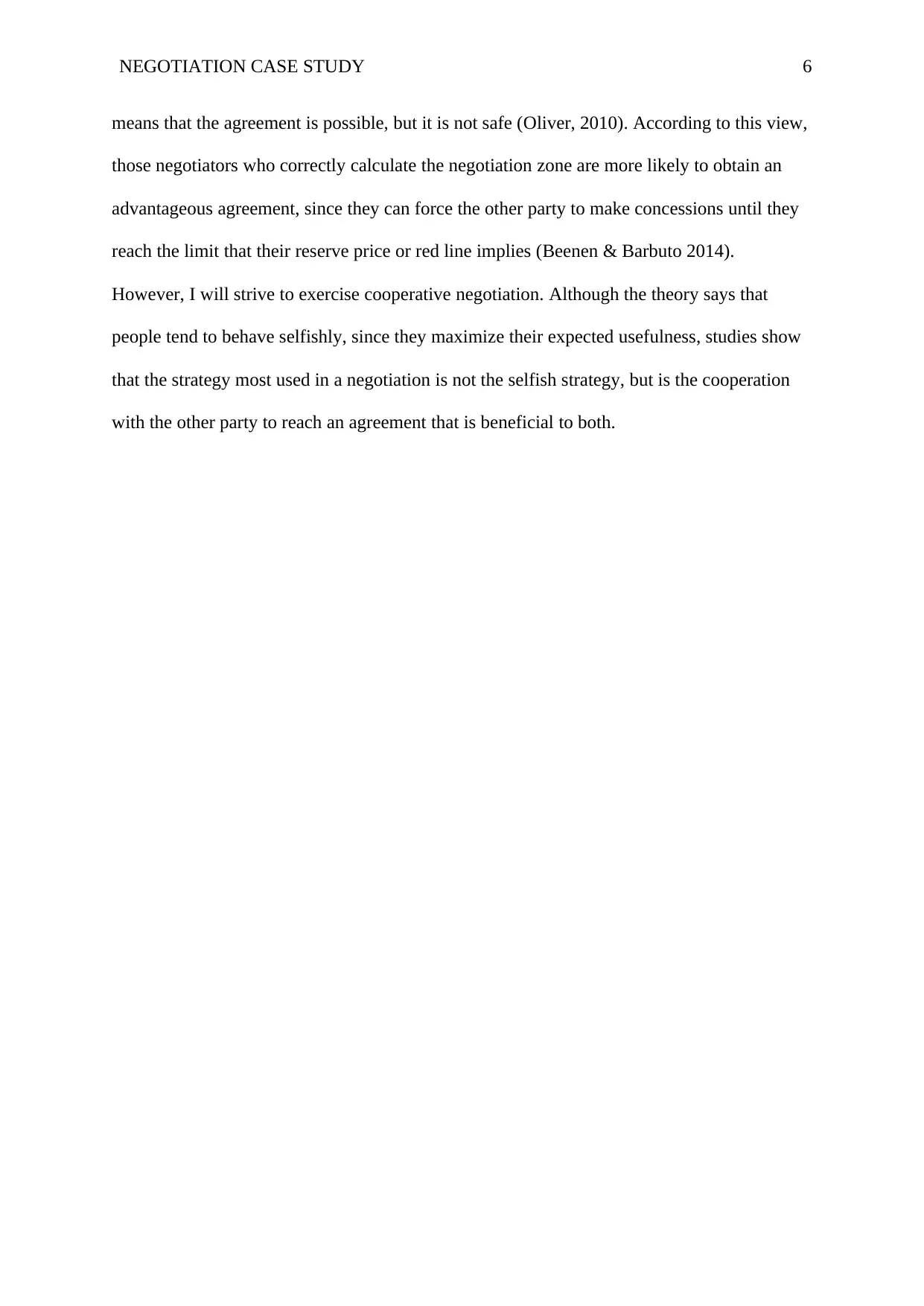
NEGOTIATION CASE STUDY 6
means that the agreement is possible, but it is not safe (Oliver, 2010). According to this view,
those negotiators who correctly calculate the negotiation zone are more likely to obtain an
advantageous agreement, since they can force the other party to make concessions until they
reach the limit that their reserve price or red line implies (Beenen & Barbuto 2014).
However, I will strive to exercise cooperative negotiation. Although the theory says that
people tend to behave selfishly, since they maximize their expected usefulness, studies show
that the strategy most used in a negotiation is not the selfish strategy, but is the cooperation
with the other party to reach an agreement that is beneficial to both.
means that the agreement is possible, but it is not safe (Oliver, 2010). According to this view,
those negotiators who correctly calculate the negotiation zone are more likely to obtain an
advantageous agreement, since they can force the other party to make concessions until they
reach the limit that their reserve price or red line implies (Beenen & Barbuto 2014).
However, I will strive to exercise cooperative negotiation. Although the theory says that
people tend to behave selfishly, since they maximize their expected usefulness, studies show
that the strategy most used in a negotiation is not the selfish strategy, but is the cooperation
with the other party to reach an agreement that is beneficial to both.
⊘ This is a preview!⊘
Do you want full access?
Subscribe today to unlock all pages.

Trusted by 1+ million students worldwide
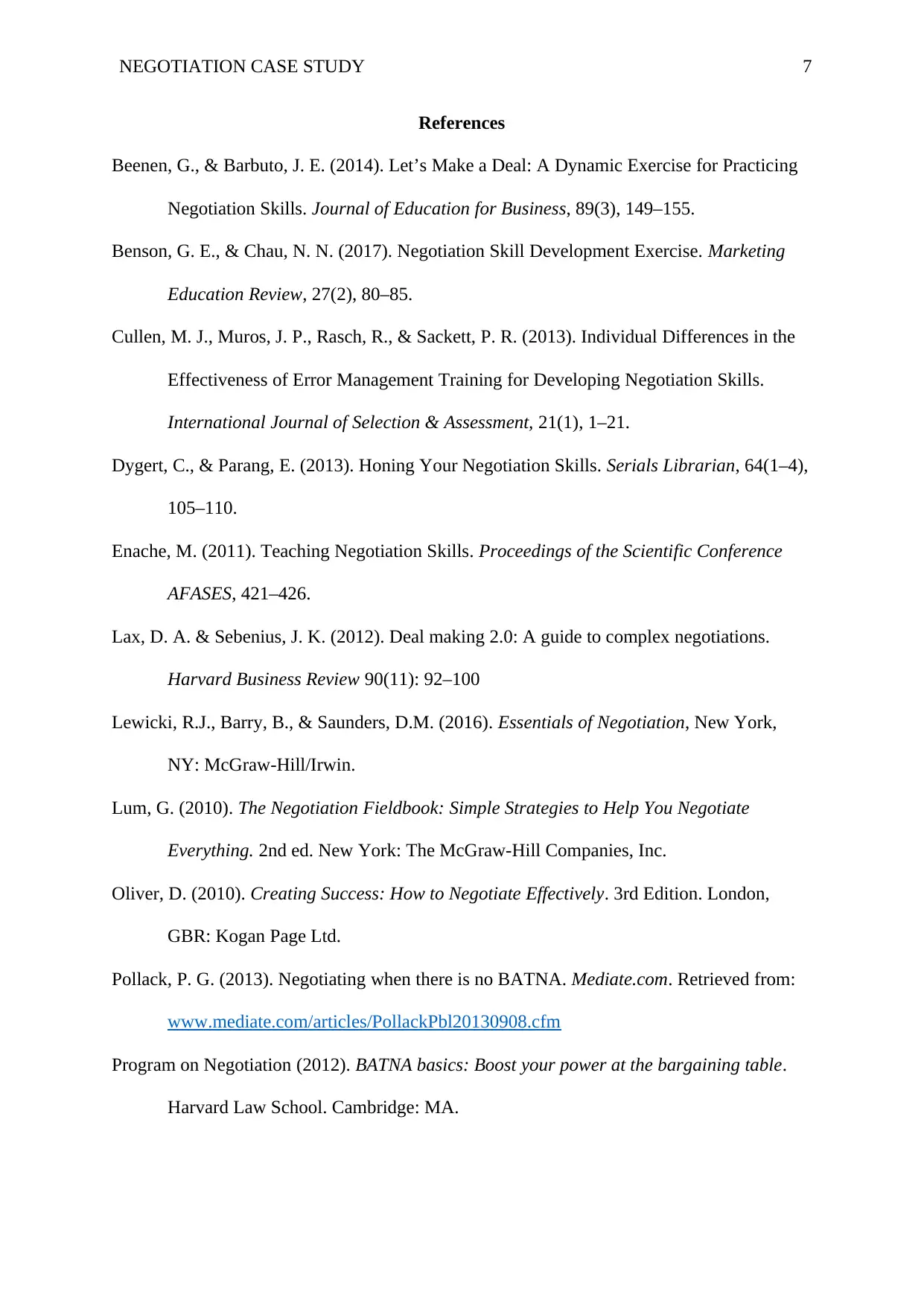
NEGOTIATION CASE STUDY 7
References
Beenen, G., & Barbuto, J. E. (2014). Let’s Make a Deal: A Dynamic Exercise for Practicing
Negotiation Skills. Journal of Education for Business, 89(3), 149–155.
Benson, G. E., & Chau, N. N. (2017). Negotiation Skill Development Exercise. Marketing
Education Review, 27(2), 80–85.
Cullen, M. J., Muros, J. P., Rasch, R., & Sackett, P. R. (2013). Individual Differences in the
Effectiveness of Error Management Training for Developing Negotiation Skills.
International Journal of Selection & Assessment, 21(1), 1–21.
Dygert, C., & Parang, E. (2013). Honing Your Negotiation Skills. Serials Librarian, 64(1–4),
105–110.
Enache, M. (2011). Teaching Negotiation Skills. Proceedings of the Scientific Conference
AFASES, 421–426.
Lax, D. A. & Sebenius, J. K. (2012). Deal making 2.0: A guide to complex negotiations.
Harvard Business Review 90(11): 92–100
Lewicki, R.J., Barry, B., & Saunders, D.M. (2016). Essentials of Negotiation, New York,
NY: McGraw-Hill/Irwin.
Lum, G. (2010). The Negotiation Fieldbook: Simple Strategies to Help You Negotiate
Everything. 2nd ed. New York: The McGraw-Hill Companies, Inc.
Oliver, D. (2010). Creating Success: How to Negotiate Effectively. 3rd Edition. London,
GBR: Kogan Page Ltd.
Pollack, P. G. (2013). Negotiating when there is no BATNA. Mediate.com. Retrieved from:
www.mediate.com/articles/PollackPbl20130908.cfm
Program on Negotiation (2012). BATNA basics: Boost your power at the bargaining table.
Harvard Law School. Cambridge: MA.
References
Beenen, G., & Barbuto, J. E. (2014). Let’s Make a Deal: A Dynamic Exercise for Practicing
Negotiation Skills. Journal of Education for Business, 89(3), 149–155.
Benson, G. E., & Chau, N. N. (2017). Negotiation Skill Development Exercise. Marketing
Education Review, 27(2), 80–85.
Cullen, M. J., Muros, J. P., Rasch, R., & Sackett, P. R. (2013). Individual Differences in the
Effectiveness of Error Management Training for Developing Negotiation Skills.
International Journal of Selection & Assessment, 21(1), 1–21.
Dygert, C., & Parang, E. (2013). Honing Your Negotiation Skills. Serials Librarian, 64(1–4),
105–110.
Enache, M. (2011). Teaching Negotiation Skills. Proceedings of the Scientific Conference
AFASES, 421–426.
Lax, D. A. & Sebenius, J. K. (2012). Deal making 2.0: A guide to complex negotiations.
Harvard Business Review 90(11): 92–100
Lewicki, R.J., Barry, B., & Saunders, D.M. (2016). Essentials of Negotiation, New York,
NY: McGraw-Hill/Irwin.
Lum, G. (2010). The Negotiation Fieldbook: Simple Strategies to Help You Negotiate
Everything. 2nd ed. New York: The McGraw-Hill Companies, Inc.
Oliver, D. (2010). Creating Success: How to Negotiate Effectively. 3rd Edition. London,
GBR: Kogan Page Ltd.
Pollack, P. G. (2013). Negotiating when there is no BATNA. Mediate.com. Retrieved from:
www.mediate.com/articles/PollackPbl20130908.cfm
Program on Negotiation (2012). BATNA basics: Boost your power at the bargaining table.
Harvard Law School. Cambridge: MA.
Paraphrase This Document
Need a fresh take? Get an instant paraphrase of this document with our AI Paraphraser

NEGOTIATION CASE STUDY 8
Spangler, B. (2012). Best alternative to negotiated agreement” In Beyond Intractability, G.
Burgess and H. Burgess, eds. Boulder CO: Conflict Information Consortium.
Retrieved from: http://www.beyondintractability.org/essay/batna.
Spangler, B. (2012). Best alternative to negotiated agreement” In Beyond Intractability, G.
Burgess and H. Burgess, eds. Boulder CO: Conflict Information Consortium.
Retrieved from: http://www.beyondintractability.org/essay/batna.
1 out of 8
Your All-in-One AI-Powered Toolkit for Academic Success.
+13062052269
info@desklib.com
Available 24*7 on WhatsApp / Email
![[object Object]](/_next/static/media/star-bottom.7253800d.svg)
Unlock your academic potential
Copyright © 2020–2025 A2Z Services. All Rights Reserved. Developed and managed by ZUCOL.